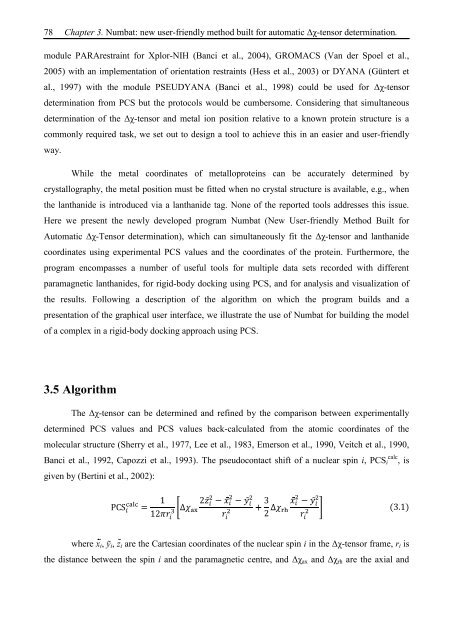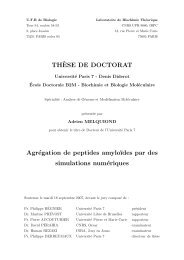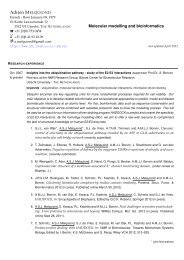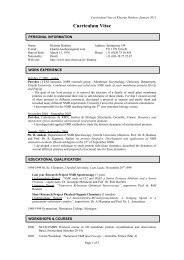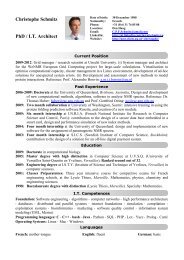Thesis Title: Subtitle - NMR Spectroscopy Research Group
Thesis Title: Subtitle - NMR Spectroscopy Research Group
Thesis Title: Subtitle - NMR Spectroscopy Research Group
Create successful ePaper yourself
Turn your PDF publications into a flip-book with our unique Google optimized e-Paper software.
78 Chapter 3. Numbat: new user-friendly method built for automatic Δχ-tensor determination.<br />
module PARArestraint for Xplor-NIH (Banci et al., 2004), GROMACS (Van der Spoel et al.,<br />
2005) with an implementation of orientation restraints (Hess et al., 2003) or DYANA (Güntert et<br />
al., 1997) with the module PSEUDYANA (Banci et al., 1998) could be used for Δχ-tensor<br />
determination from PCS but the protocols would be cumbersome. Considering that simultaneous<br />
determination of the Δχ-tensor and metal ion position relative to a known protein structure is a<br />
commonly required task, we set out to design a tool to achieve this in an easier and user-friendly<br />
way.<br />
While the metal coordinates of metalloproteins can be accurately determined by<br />
crystallography, the metal position must be fitted when no crystal structure is available, e.g., when<br />
the lanthanide is introduced via a lanthanide tag. None of the reported tools addresses this issue.<br />
Here we present the newly developed program Numbat (New User-friendly Method Built for<br />
Automatic Δχ-Tensor determination), which can simultaneously fit the Δχ-tensor and lanthanide<br />
coordinates using experimental PCS values and the coordinates of the protein. Furthermore, the<br />
program encompasses a number of useful tools for multiple data sets recorded with different<br />
paramagnetic lanthanides, for rigid-body docking using PCS, and for analysis and visualization of<br />
the results. Following a description of the algorithm on which the program builds and a<br />
presentation of the graphical user interface, we illustrate the use of Numbat for building the model<br />
of a complex in a rigid-body docking approach using PCS.<br />
3.5 Algorithm<br />
The Δχ-tensor can be determined and refined by the comparison between experimentally<br />
determined PCS values and PCS values back-calculated from the atomic coordinates of the<br />
molecular structure (Sherry et al., 1977, Lee et al., 1983, Emerson et al., 1990, Veitch et al., 1990,<br />
Banci et al., 1992, Capozzi et al., 1993). The pseudocontact shift of a nuclear spin i, PCSi calc , is<br />
given by (Bertini et al., 2002):<br />
(3.1)<br />
where i, i, i are the Cartesian coordinates of the nuclear spin i in the Δχ-tensor frame, ri is<br />
the distance between the spin i and the paramagnetic centre, and Δχax and Δχrh are the axial and


